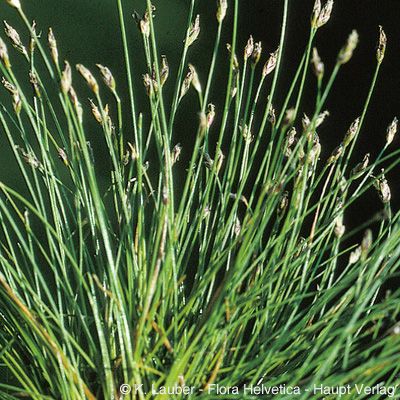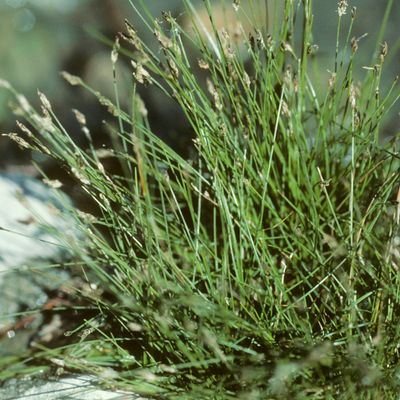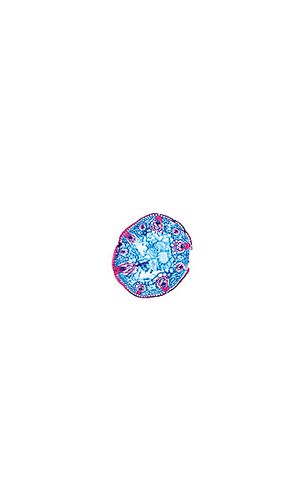Eleocharis acicularis (L.) Roem. & Schult.
1016220
Species
ISFS : 145000
Checklist : 1016220
ISFS : 145000
Checklist : 1016220
Contains :
Synthesis
Species description (© Flora Helvetica 2018)
2-10(-20) cm hoch, Stängel fadenförmig (0,2-0,4 mm dick), undeutlich 3-4kantig, blattlos, viele Stängel steril (nur bei dieser E.-Art), sehr dichte Rasen bildend. Grundständige Blattscheiden oft rot. Ähre spitz spindelförmig, 2-4 mm lang, meist 3-8blütig. Perigonborsten meist fehlend. Narben 3. Frucht spindelförmig, weisslich glänzend, ca. 1 mm lang.Flowering period (© Flora Helvetica 2018)
6-8Habitat and distribution inside Switzerland (© Flora Helvetica 2018)
Feinsandige, zeitweise überschwemmte Strandzonen / kollin-subalpin / M, J, vereinzelt AWorld distribution (© Flora Helvetica 2018)
Eurasiatisch-nordamerikanischEcological indicator (© Landolt & al. 2010)
5w+42+43+3.h.2n=20Status
IUCN status
VulnerableNational Priority
4 - weak national priorityInternational responsibility
1 - weakConservation
Threats
Anatomy
Summary of stem anatomy (German)
Umriss rund oder oval. Leitbündel in einer Reihe. Rechteckige Stützen. Epidermiszellen aussen verholzt.Description
Culm-diameter < 0.5 mm, center full, radius of culm in relation to wall thickness 1:1. Outline circular with a smooth surface. Culm-center full, containing unlignified cells. Epidermis cells inside thin, peripheral thicker-walled (lignified). Guard cells externally rounded off. Large vascular bundles arranged in one peripheral row. Small or rudimentary vascular bundles within the chlorenchyma. Chlorenchyma in round, oval, square or rectangular groups. Sclerenchyma belt absent. Groups of sclerenchyma square or rectangular. Sclerenchymatic sheath around vascular bundles bilateral, large at both radial ends. Vessels arrangement in vascular bundles in lateral position. Largest vessel in the bundle small, < 20μm. Cavities (intercellulars) between parenchyma cells absent. Distinct cavities (intercellulars) in the protoxylem area of vascular bundles.Distribution map
Habitat and distribution inside Switzerland
M, J, vereinzelt AWorld distribution
Eurasiatisch-nordamerikanischEcology
Life form
Perennial hemicryptophyte
Habitats
Milieux Phytosuisse (© Prunier et al. 2017)
Habitats © Delarze & al. 2015
 | 2.1.3 - Strandlingsgesellschaften (Littorellion) |
bold
Dominant species, influencing the appearance of the habitat
 Character species
Character species
 Less strictly linked to a specific habitat
Less strictly linked to a specific habitat
Ecological indicator values by © Landolt & al. (2010)
| Soil factors | Climatic factors | Salinity tolerance | |||
|---|---|---|---|---|---|
| Humidity Value H | 5w+ | Light Value L | 4 | Salinity Index | 1 |
| Reaction Value R | 4 | Temperature factor T | 3+ | ||
| Nutriments value N | 2 | Continentality K | 3 | ||
- Ecological values legend
Humidity Value H 1 very dry 1+ dry 2 moderatly dry 2+ moist 3 medium wet 3+ wet 4 very wet 4+ soggy 5 submerged or underwater f plants living in running water u mostly submerged plants v partly submerged, partly floating plants w humidity moderately variable (± scale of 1-2) w+ highly variable humidity (scale exceeding ± 2) Reaction Value R 1 Very acid (pH 2.5-5.5) 2 acid (pH 3.5-6.5) 3 lightly acid to neutral (pH 4.5-7.5) 4 neutral to basic (pH 5.5-8.5) 5 basic (pH 6-5 -> 8.5 Nutriments value N 1 very low in nutrients 2 low in nutriments 3 medium-poor to medium-rich in nutrients 4 rich in nutriments 5 very rich in nutriments Salinity tolerance 1 halotolerant 3 halophyle Light Value L 1 very shady 2 shady 3 lighted areas 4 luminous 5 highly luminous Temperature factor T 1 alpine to nival stages (from the treeline to the snowline) 1+ suprasubalpine and upper subalpine levels (pine and larch forests) 2 subalpine level (coniferous forests without beeches up to the upper limit of spruces) 2+ lower subalpine and upper mountain stages 3 mountain level (beech and silver fir forests, in the central Alps Scots pine forests) 3+ lower mountain and upper hill levels 4 hill level (mixed deciduous oak forests) 4+ hot places, hill level 5 very hot places, hill level (only in the hottest places, typical of southern Europe) Continentality K 1 Atlantic (high air humidity, very low temperature variations, mild winters) 2 Sub-Atlantic (high air humidity, low temperature variations, relatively mild winters) 3 sub-Atlantic to subcontinental (average air humidity, moderately variable temperature, slightly low winter temperatures) 4 subcontinental (low air humidity, large temperature variations, rather cold winters) 5 continental (very low air humidity, very large temperature variations, cold winters)
Water dependency
| Rivers | 0 - No link |
| Calm water | 2 - Essential habitat |
| Ground water | 0 - No link |
Nomenclature
Accepted Name (Checklist 2017)
Eleocharis acicularis (L.) Roem. & Schult.
Vernacular name
Deutscher Name :
Nadel-Sumpfbinse, Nadelbinse, NadelriedNom français :
Héléocharis épingleNome italiano :
Giunchina aghiformeMatch with other reference books
| Relation | Nom | Book | No |
|---|---|---|---|
| = | Eleocharis acicularis (L.) Roem. & Schult. | Checklist 2017 | 145000 |
| = | Eleocharis acicularis (L.) Roem. & Schult. | Flora Helvetica 2001 | 2497 |
| = | Eleocharis acicularis (L.) Roem. & Schult. | Flora Helvetica 2012 | 2673 |
| = | Eleocharis acicularis (L.) Roem. & Schult. | Flora Helvetica 2018 | 2673 |
| = | Eleocharis acicularis (L.) Roem. & Schult. | Index synonymique 1996 | 145000 |
| = | Eleocharis acicularis (L.) Roem. & Schult. | Landolt 1977 | 422 |
| = | Eleocharis acicularis (L.) Roem. & Schult. | Landolt 1991 | 371 |
| = | Eleocharis acicularis (L.) Roem. & Schult. | SISF/ISFS 2 | 145000 |
| = | Eleocharis acicularis (L.) Roem. & Schult. | Welten & Sutter 1982 | 2403 |
= The taxon corresponds to the accepted taxon (Checklist 2017)
< The taxon is included in the accepted taxon (Checklist 2017)
> The taxon includes (among others) also the accepted taxon (Checklist 2017)
< The taxon is included in the accepted taxon (Checklist 2017)
> The taxon includes (among others) also the accepted taxon (Checklist 2017)
Status
Native status
-IUCN list of endangered species (© Walter & Gillett 1997) : No
Status on national Red List 2016
IUCN status:
Vulnerable

Additional information
IUCN criteria: B2b(iii)c(iv)
Status on regional Red List 2019
| Biogregraphic regions | Status | IUCN criteria |
|---|---|---|
| Jura (JU) | VU | B2b(iii)c(iv) |
| Mittelland (MP) | EN | B2b(iii)c(iv) |
| Alpennordflanke (NA) | VU | B2b(iii)c(iv) |
| Alpensüdflanke (SA) | EN | B2ab(iii)c(iv) |
| Östliche Zentralalpen (EA) | EN | B2ab(iii)c(iv) |
| Westliche Zentralalpen (WA) | RE |
- Legend
EX Extinct RE Regionally Extinct CR(PE) Critically Endangered, Probably Extinct CR Critically Endangered EN Endangered VU Vulnerable NT Near Threatened LC Least Concern DD Data Deficient NE Not Evaluated NA Not Applicable
National Priority Species List Status
| National Priority | 4 - weak national priority |
| Need to take action | 2 - |
| International responsibility | 1 - weak |
| Need to monitor populations | 1 - |
Protection status
| International (Bern Convention) | No | |
| AG | total protection | (01.01.2010) |
| GE | total protection | (25.07.2007) |
| Switzerland | -- | |
| VD | total protection | (02.03.2005) |
| TI | total protection | (23.01.2013) |
- Disclaimer
InfoFlora compiles information on protected species as accurately as possible, taking it from the respective cantonal laws. In some cases, however, it was not possible to use the plant names as listed in the original text, but an interpretation of their taxonomy or nomenclature was necessary. The exact meaning of the categories „completely protected“ and „partially protected“ differs among the cantons.
InfoFlora cannot guarantee that the information on the protection status is correct and complete. In case of doubts, we recommend to look up the texts of the respective cantonal law.
Status by sector of activity
| Agriculture-related environmental objectives : | more informations | |
| Forest management environmental objectives : | more informations |





